By Mark Lewis | STC Associate Fellow
 In the content world, metrics can be used to prove a business case, communicate value, or predict costs and savings. This column explores new thoughts and ideas in the area of metrics and ROI. Please send your ideas, comments, and questions to mlewis@ditametrics.com.
In the content world, metrics can be used to prove a business case, communicate value, or predict costs and savings. This column explores new thoughts and ideas in the area of metrics and ROI. Please send your ideas, comments, and questions to mlewis@ditametrics.com.
I’d like to share research and findings that I presented at the Intelligent Content Conference for Life Sciences 2014 (www.slideshare.net/hyperwriters/the-roi-of-intelligent-content-for-life-sciences). While trying to pick a presentation topic, it occurred to me that I had not heard many discussions about how compliance-related tasks could benefit from the content reuse capabilities of XML-based intelligent content. That is the focal point of my presentation and this article.
Procedures are a common content type that is familiar to life sciences and technical writers, so let’s use the procedure content type for this discussion. The processes and cost models in this column are examples that are meant to be customized to match the roles and tasks in the content processes in your organization. I hope they give you a jumpstart. Let’s:
- Design a cost model for a basic procedure without content reuse
- Design a cost model for a basic procedure with content reuse
- Design a cost model for a structured
authoring process without content reuse - Design a cost model for a structured authoring process with content reuse
- Compare the cost models and determine the savings with reuse
Design a cost model for a basic procedure without content reuse
Let’s design a cost model for a basic procedure without reuse. Figure 1 shows the content elements that are typically included in a procedure.
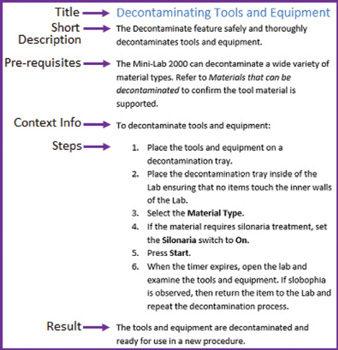
The cost model should represent the average cost for an author to create a procedure. Cost is expressed in labor hours. The first step is to create a table that includes the content elements in a procedure (see Table 1). For each content element, include the average number of occurrences of that element in a procedure. Next, include the average amount of time required to author each element. The amounts must reflect writing all content with no content reuse. To customize the models, you need to review a sample set of your organization’s procedures and determine your own averages.
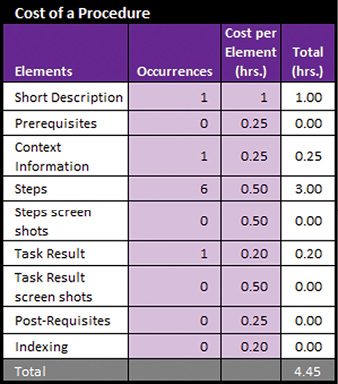
Let’s calculate the average cost to create a procedure without reuse. The calculation is:
Cost of procedure without content reuse = Summation of ((average number of occurrences of an element) x (average cost per element)) = 4.45 hours
Design a cost model for a basic procedure with content reuse
To determine the cost of a basic procedure with content reuse, we need a value for the average percent reuse. However, the process for determining an accurate percent reuse involves many steps, but because of the limited length of a magazine article, we have to simplify that process and use a rule-of-thumb reuse percentage of 25%. For details on that process, see the “Content Reuse” chapter of my book, DITA Metrics 101 (www.ditametrics.com).
Let’s calculate the average cost of authoring a procedure with reuse. We already know the savings is 25%, but we’ll need the value in labor hours later in this discussion.
The calculation is:
Cost of a procedure with reuse = ((cost of a procedure without reuse) x (1.0 – percent reuse)) = (4.45 x (1.0 – 0.25)) = 4.45 x 0.75 = 3.34 hours
We can use this same formula to determine the cost for other roles involved in the content lifecycle.
Design a cost model for a structured authoring process without content reuse
Next, let’s look at a structured authoring process that does not include content reuse. When I teach this concept, I design a process with an author, technical reviewer, and editor. But this discussion is about compliance, so let’s replace the technical reviewer’s role with a compliance reviewer (see Figure 2). Your situation may be different, so customize the roles and tasks to represent the process in your organization.
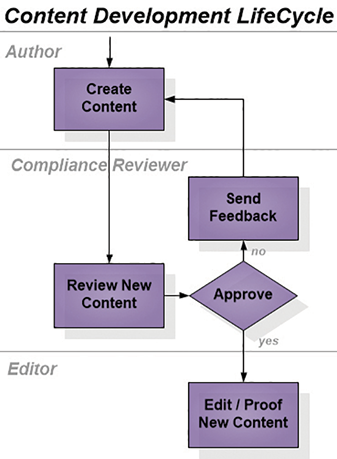
Figure 2. A structured authoring process without content reuse
The equivalent cost model represents the average cost of the process to create a procedure for all roles involved. The first step is to create a table that includes each role and the tasks they perform in the process (see Table 2). Next, include the average amount of time to perform each task. The time estimates are based on the basic procedure which contains an average number of each content element and an average amount of content in each of those elements.
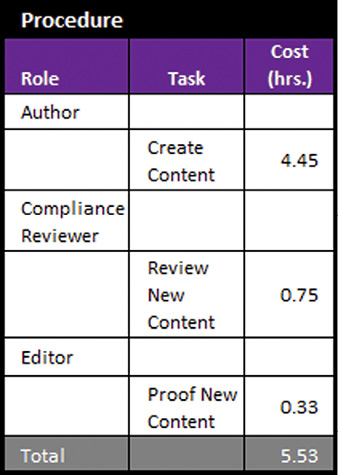
Let’s calculate the cost of the structured authoring process without reuse.
The values are:
- Cost to create new content for a basic procedure = 4.45 hours from Table 2
- Cost to compliance review new content for a basic procedure = 0.75 hours
- Cost to editor proof new content for a basic procedure = 0.33 hours
The calculation is:
Cost of the structured authoring process without content reuse = (cost to create new content) + (cost to compliance review new content) + (cost to editor proof new content) = 4.45 + 0.75 + 0.33 = 5.53 hours
Design a cost model for a structured authoring process with content reuse
Let’s now look at a structured authoring process that includes content reuse. First, let’s discuss how the process is different for each role when reusable content is included. When the author is writing the procedure, they avoid writing content from scratch whenever possible. The author searches for and inserts reusable content. The remaining content that is needed must be written by the author and is treated as new content.
In many structured authoring tools, the system shades the background of reused (referenced) content (see Figure 3). This makes it easy for the user to distinguish new content from reused content. This is important for the compliance reviewer and editor, because they know that the content with a shaded background has already been reviewed and proofed and they only need to perform what is known as a contextual review of the reused content. A contextual review determines if that content is appropriate or fits in the context of the other content. Performing a contextual review of vetted reusable content takes less effort than a full review or proof of new content (see Figure 4). This is where the biggest savings occur. In our example, this reduces the efforts on new content by the compliance reviewer and editor by the rule-of-thumb reuse percentage of 25%.
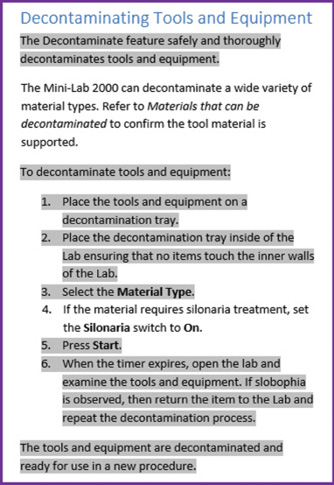
The equivalent cost model represents the average cost of the process to create a procedure for all roles involved. First, create a table that includes each role and the tasks they perform in the process. Next, include the average amount of time to perform each task. Remember that this is being performed on the “basic procedure” (see Table 3).
Let’s calculate the cost of the structured authoring process with content reuse. The values are:
- Rule-of-thumb reuse percentage = 25% = 0.25
- Cost to find and insert reusable content = 0.11 hours
- Cost of compliance contextual review of reused content = 0.10 hours
- Cost of editor contextual review of reused content = 0.08 hours
The calculations are:
- A = Cost to create new content with reuse = (cost to create content without reuse) x (1.0 – rule-of-thumb reuse percentage) = 4.45 x (1.0 – 0.25) = 4.45 x 0.75 = 3.34 hours
- B = Cost for compliance review of new content with reuse = (cost to review new content without reuse) x (1.0 – rule-of-thumb reuse percentage) = 0.75 x (1.0 – 0.25) = 0.75 x 0.75 = 0.56 hours
- C = Cost to proof new content with reuse = (cost to review new content without reuse) x (1.0 – rule-of-thumb reuse percentage) = 0.33 x (1.0 – 0.25) = 0.33 x 0.75 = 0.25 hours
- Cost of the structured authoring process with content reuse = A + (cost to find and insert reusable content) + B + (cost of compliance contextual review of reused content) + C + (cost of editor contextual review of reused content) = 3.34 + 0.11 + 0.56 + 0.10 + 0.25 + 0.08 = 4.44 hours
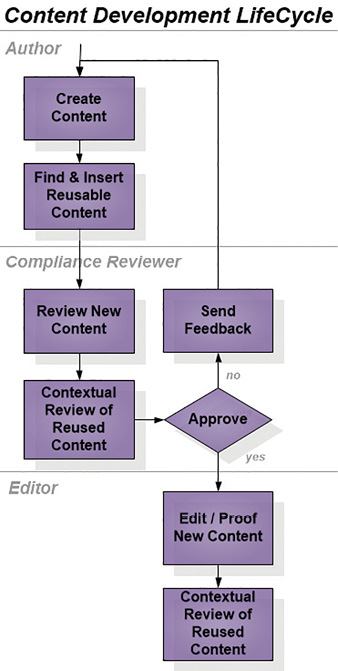
Compare the cost models and determine the savings with reuse
For the structured authoring process as a whole, incorporating content reuse reduced the cost from 5.53 hours from Table 3 to 4.44 hours. This is an overall savings of 19.7%.
For the compliance reviewer, incorporating content reuse reduced their effort from 0.75 hours from Table 2 to 0.66 hours from Table 3. This is a savings of 12.0%.
Even though we’ve simplified some of the calculations by using a rule-of-thumb percent reuse, the results still show that significant savings are possible for all roles involved in the process.
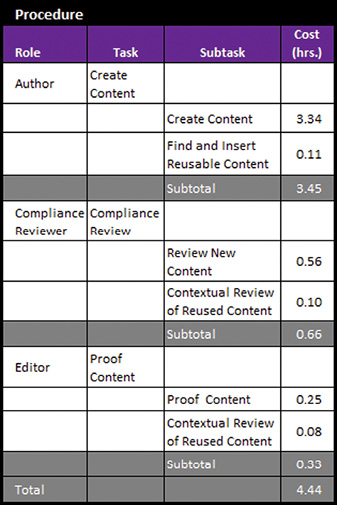
Conclusion
In this article and in my book, DITA Metrics 101 (http://www.ditametrics.com/), I prove the savings possible when intelligent content and content reuse are applied to the content development lifecycle. I show how to design cost models for a structured authoring process with and without content reuse. The difference in cost is the savings, which is substantial in all cases. The models that I discuss here are intended to give you a jumpstart and are meant to be customized to match the roles and tasks in the content processes in your organization. In the book, the example process involves the following roles: author, technical reviewer, and editor. In my life sciences presentation and in this article, I customized the example process to include a compliance reviewer. We proved how each role could benefit from the content reuse capabilities of intelligent content. The efforts of many tasks are reduced when content is reused. The compliance reviewer’s savings is 12.0%. The overall savings for the structured authoring process is 19.7%. These savings are calculated based on a rule-of-thumb content reuse percentage of 25%. The higher the percent reuse, the greater the overall savings.
The processes in your organization may include additional roles, but I hope you can see how easy it is to add these roles and tasks to the models in this article. I encourage you to take these example processes and metrics and customize them to your organization to prove the savings that you could achieve. Please share your results with the community.


